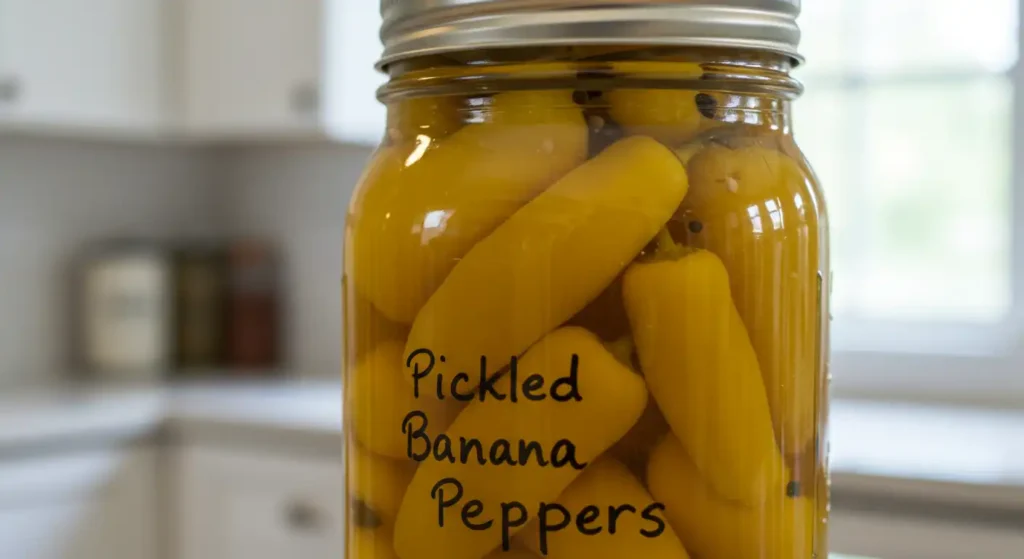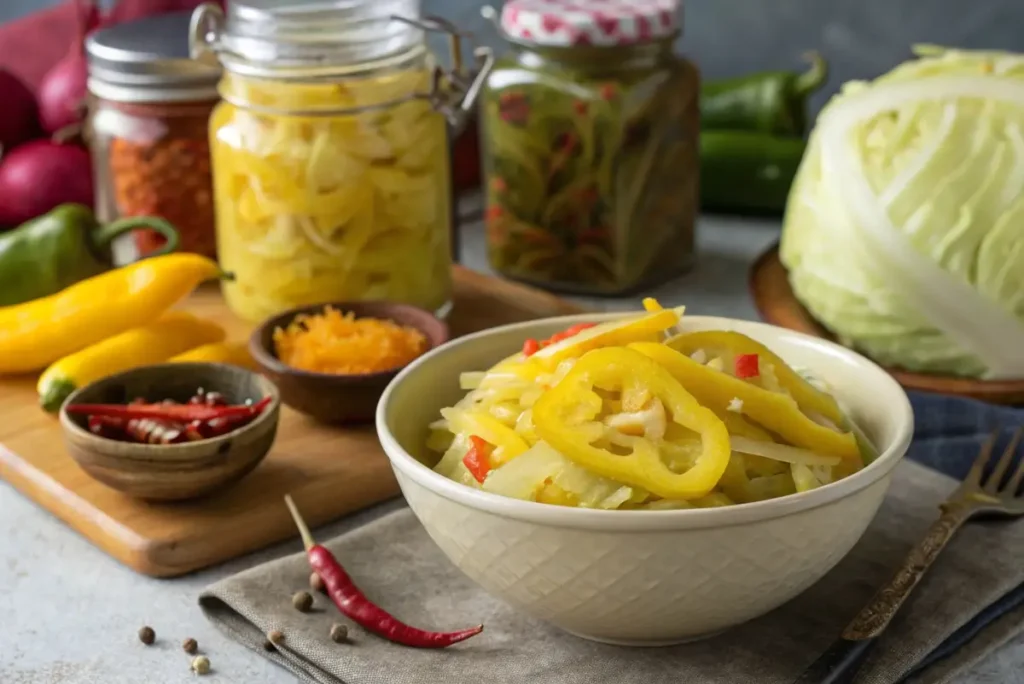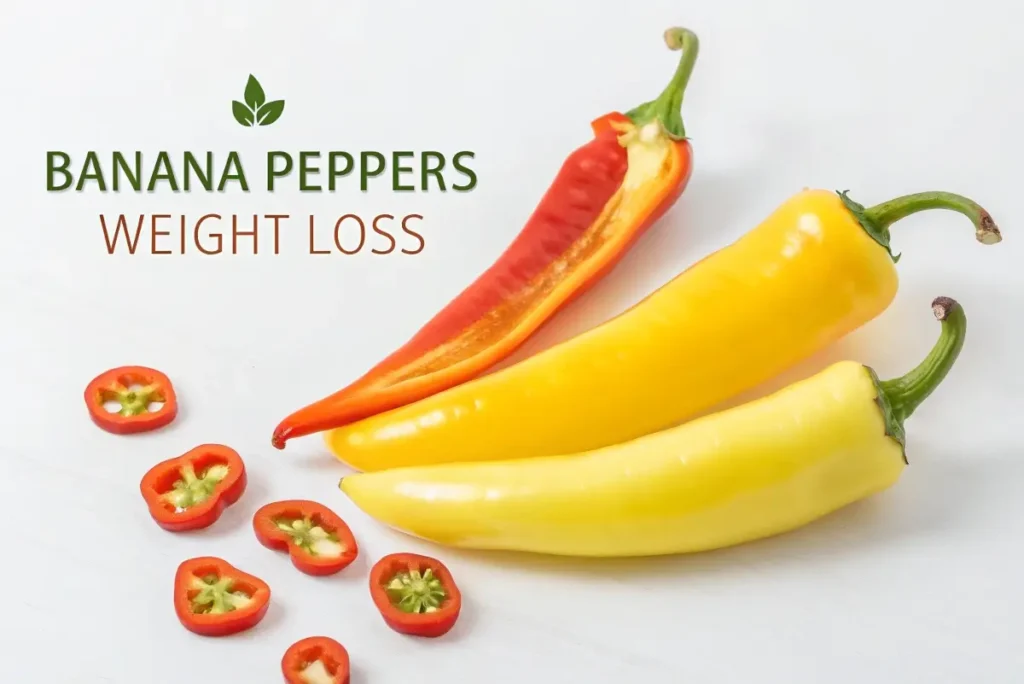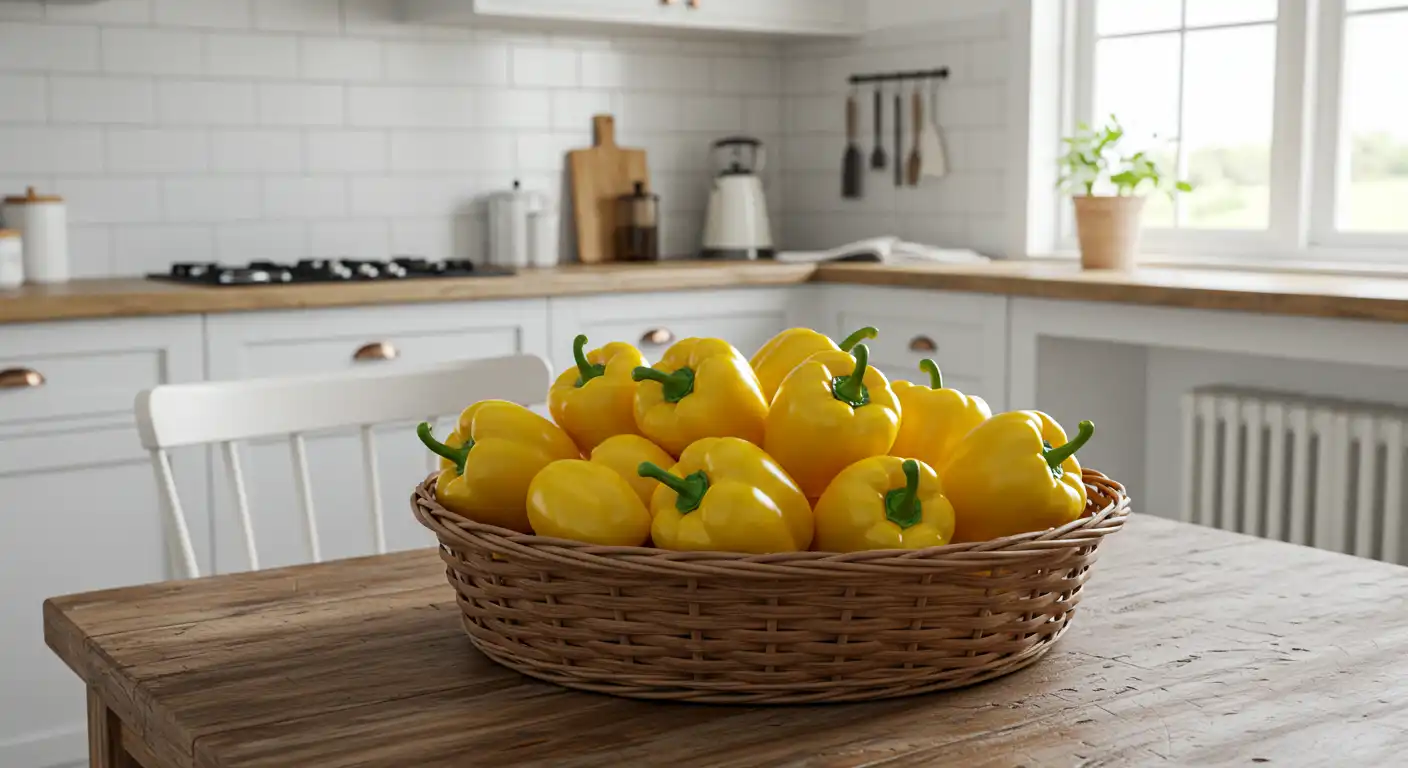Introduction: A Question of Flavor
Are banana peppers hot or sweet? This question has intrigued food enthusiasts for years. These vibrant peppers, known for their unique flavor and versatility, can be a delightful addition to countless dishes. But what exactly defines their taste? Let’s dive into the world of banana peppers and uncover their secrets. From their culinary uses to their nutritional benefits and cultural history, this guide covers everything you need to know.
What Are Banana Peppers?
Banana peppers are elongated, yellowish-green peppers named for their resemblance to bananas. Their mild and tangy flavor makes them a popular choice for various culinary uses. These peppers belong to the Capsicum annuum family, sharing lineage with bell peppers and jalapeños.
Key Features of Banana Peppers: Sweet and Tangy
- Appearance: Banana-shaped, ranging from yellow to red when fully ripe.
- Heat Level: Mild, measuring 0 to 500 Scoville Heat Units (SHU).
- Flavor Profile: Sweet with a slight tang, making them family-friendly.
Fun Fact:
Banana peppers are often mistaken for pepperoncini. While similar, banana peppers are milder and sweeter, making them a go-to option for less spicy recipes.
Varieties of Banana Peppers: Sweet and Spicy Options
- Sweet Banana Peppers: Perfect for fresh salads or pickling.
- Hungarian Wax Peppers: Often confused with banana peppers but much spicier.
Are Banana Peppers Hot or Sweet? Exploring Their Unique Taste
The answer lies in their variety and ripeness. Generally, banana peppers are sweet with a mild tang. However, when allowed to ripen fully, their heat intensifies slightly. Despite this, they remain far milder than other peppers like jalapeños or habaneros.
Breaking It Down:
- Young Banana Peppers: Mild and tangy, perfect for fresh salads and pickling.
- Ripe Banana Peppers: Slightly sweeter with a touch of heat, ideal for roasting or stuffing.
Comparison:
| Pepper Type | Heat Level (SHU) | Flavor Profile |
|---|---|---|
| Banana Peppers | 0–500 | Sweet and tangy |
| Jalapeños | 2,500–8,000 | Spicy and earthy |
| Bell Peppers | 0 | Sweet and mild |
Nutritional Benefits : Are banana peppers hot or sweet?
Banana peppers aren’t just flavorful; they’re also packed with nutrients that contribute to overall health. These vibrant peppers are a nutrient powerhouse that can easily enhance your diet.
| Nutrient | Amount (per 100g) | Daily Value (%) |
| Calories | 27 | 1% |
| Vitamin C | 183 mg | 203% |
| Vitamin A | 200 IU | 4% |
| Potassium | 210 mg | 6% |
| Fiber | 1.7 g | 7% |
Health Benefits of Banana Peppers: Sweetness with Nutrition
- Boosts Immunity: High Vitamin C content strengthens the immune system and helps combat illnesses.
- Supports Heart Health: Potassium aids in regulating blood pressure and reducing heart disease risks.
- Enhances Digestion: Dietary fiber improves gut health and prevents constipation.
- Aids Weight Management: Their low calorie count makes them a guilt-free snack option.
- Rich in Antioxidants: Helps fight free radicals, reducing the risk of chronic diseases.
Fun Tip: Adding Banana Peppers to Boost Your Diet
Add banana peppers to your post-workout smoothie for a surprising, tangy nutrient boost!
Joke Break:
Why did the banana pepper go to the gym?
To get “hotter” and stay in “shape”!
Are banana peppers hot or sweet? Culinary Uses of Banana Peppers: Sweet and Versatile Ideas
Banana peppers’ mild and sweet flavor makes them incredibly versatile. They can be used fresh, pickled, or cooked to elevate various dishes. Whether you’re a beginner cook or a seasoned chef, banana peppers can fit into your kitchen with ease.

Popular Ways to Cook with Sweet Banana Peppers
- Toppings: Add to pizzas, sandwiches, or hot dogs for a tangy crunch.
- Stuffed: Fill with cheese, rice, or meat for a hearty appetizer.
- Pickled: A classic addition to salads, wraps, and charcuterie boards.
- Grilled: Roast on skewers for a smoky, caramelized flavor.
- Raw: Chop into salads for a refreshing kick.
- Salsas: Dice and mix with tomatoes, onions, and cilantro for a unique twist.
Quick Recipe: Pickled Banana Peppers for a Tangy Treat
- Slice fresh banana peppers into rings.
- Combine vinegar, water, sugar, and salt in a saucepan.
- Heat until the sugar dissolves.
- Pour the mixture over the pepper rings in a jar.
- Seal and refrigerate for 24 hours before enjoying.

Growing Banana Peppers at Home: A Guide for Sweet Success
Cultivating banana peppers at home is simple and rewarding. These peppers thrive in warm weather and well-draining soil. Whether you’re an experienced gardener or a beginner, banana peppers are easy to grow.
Tips for Thriving Sweet Banana Pepper Plants
- Planting: Start seeds indoors 6–8 weeks before the last frost. Transplant seedlings once the soil warms.
- Soil Requirements: Use nutrient-rich, well-draining soil with a pH between 6.2 and 7.0.
- Sunlight: Ensure at least 6–8 hours of direct sunlight daily.
- Watering: Water consistently but avoid overwatering to prevent root rot.
- Fertilizing: Apply a balanced fertilizer every 4–6 weeks to encourage healthy growth.
Banana Peppers in Global Cuisines
Banana peppers are celebrated in cuisines worldwide for their versatility and mild flavor. Their adaptability makes them a staple in many culinary traditions.
Highlights:
- Mediterranean: Featured in Greek salads, stuffed with feta cheese, or added to mezze platters.
- Italian: Found on antipasto platters, pizzas, and in pasta dishes for a tangy contrast.
- Tex-Mex: Used as a topping for tacos, nachos, and enchiladas.
- American: A staple in Chicago-style hot dogs and deli sandwiches.
How to Preserve Banana Peppers
Preserving banana peppers ensures they can be enjoyed year-round. Their mild sweetness lends itself to various preservation methods.
Methods:
- Freezing: Slice and store in airtight freezer bags for up to 6 months.
- Pickling: Use a vinegar brine for long-lasting tangy peppers.
- Canning: Store in sterilized jars to enjoy throughout the year.
- Dehydrating: Dry slices to create pepper flakes or powder.
Pro Tip:
Label jars with the date and spice level to keep track of your preserved peppers.
Creative Recipes Featuring Banana Peppers
Explore unique ways to use banana peppers in your cooking. Their mild flavor allows them to adapt to various creative recipes.
Ideas:
- Banana Pepper Relish: Blend peppers with onions and spices for a flavorful condiment.
- Pepper Jelly: Create a sweet and spicy spread perfect for crackers or toast.
- Stuffed Banana Pepper Boats: Hollow peppers and fill with taco meat and cheese for a Tex-Mex twist.
- Banana Pepper Soup: A creamy soup with roasted banana peppers, potatoes, and garlic.
The History of Banana Peppers
Banana peppers have a rich history that dates back centuries. Originally cultivated in Central and South America, they gained popularity worldwide due to their mild flavor and versatility. European explorers introduced them to the Mediterranean, where they became a staple in regional dishes. Today, they’re celebrated globally for their culinary and nutritional value.
Tips for Picking Perfect Banana Peppers
When selecting banana peppers, freshness is key to maximizing their flavor and texture. Follow these tips for the best results:
- Color: Choose peppers with vibrant yellow or red hues.
- Firmness: Look for firm peppers without soft spots or blemishes.
- Size: Opt for medium-sized peppers, which tend to have the best balance of flavor and texture.
Banana Peppers for Kids: Making Meals Fun
Introducing banana peppers to kids can be a fun way to expand their palate. Here are some creative ideas:
- Mini Stuffed Peppers: Fill with cream cheese or hummus for a kid-friendly snack.
- Pepper “Fries”: Slice into strips, bake, and serve with ketchup or ranch.
- Banana Pepper Pizza: Add mild banana peppers to a cheese pizza for a tangy twist.
Banana Peppers in Fermented Foods

Fermentation is a fantastic way to extend the shelf life of banana peppers while enhancing their flavor profile. These tangy delights are a staple in probiotic-rich diets and are great for gut health.
How to Ferment Banana Peppers:
- Slice the peppers into rings or leave them whole.
- Place them in a clean jar with garlic, dill, and spices for extra flavor.
- Dissolve salt in water to create a brine and pour it over the peppers.
- Seal the jar loosely and let it sit at room temperature for 5–7 days.
- Once fermented, store the jar in the refrigerator to enjoy their tangy flavor anytime.
Fermented banana peppers make an excellent addition to sandwiches, burgers, and wraps while delivering digestive health benefits.
Common Myths About Banana Peppers
There are plenty of misconceptions about banana peppers. Let’s debunk a few of the most common ones:
- Myth 1: Banana peppers are always sweet.
Truth: While most banana peppers are sweet, their ripeness can add a slight kick of heat. - Myth 2: Cooking reduces their nutritional value.
Truth: Banana peppers retain most of their nutrients even when roasted or grilled. - Myth 3: They can’t be grown in colder climates.
Truth: With proper care, banana peppers can thrive in cooler areas during the summer months. Using greenhouses or grow lights can extend their growing season.
Understanding the facts about banana peppers can help you enjoy them more confidently in your recipes.
Banana Peppers for Weight Loss

Banana peppers are not only delicious but also a secret weapon for weight management. Their low-calorie content and natural sweetness can help curb cravings while keeping your meals satisfying.
Why They’re Great for Weight Loss:
- Low Calorie: With only 27 calories per 100 grams, they’re perfect for calorie-conscious meals.
- High Fiber: Their fiber content helps you feel full for longer and aids digestion.
- Versatility: Use them in salads, stir-fries, or even as a snack to replace high-calorie options.
Meal Prep Ideas:
- Stuffed Banana Peppers: Fill with quinoa, black beans, and a sprinkle of low-fat cheese for a healthy lunch.
- Banana Pepper Wraps: Use large banana peppers as a low-carb wrap alternative, stuffed with lean proteins and veggies.
- Banana Pepper Chips: Slice thinly, bake until crisp, and enjoy as a low-calorie snack.
Incorporating banana peppers into your diet can make healthy eating flavorful and sustainable.
Frequently Asked Questions: Are banana peppers hot or sweet?
Are Banana Peppers Healthy to Eat?
Yes, they’re rich in Vitamin C, fiber, and potassium, supporting immunity, digestion, and heart health.
Are Banana Peppers Like Jalapeños?
No, banana peppers are milder and sweeter, with a heat level of 0–500 SHU compared to jalapeños’ 2,500–8,000 SHU.
Conclusion: Are banana peppers hot or sweet?
Are banana peppers hot or sweet? The answer is both, depending on their ripeness and preparation. Their versatility, nutritional benefits, and unique flavor make them a must-have in any kitchen. Whether you’re looking for a mild topping or a sweet and tangy snack, banana peppers are the perfect choice.
